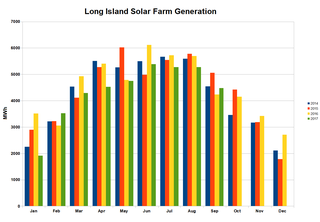Related Research Articles
The bit is a basic unit of information in information theory, computing, and digital communications. The name is a portmanteau of binary digit.

Computer data storage is a technology consisting of computer components and recording media that are used to retain digital data. It is a core function and fundamental component of computers.
Fuzzy logic is a form of many-valued logic in which the truth values of variables may be any real number between 0 and 1 both inclusive. It is employed to handle the concept of partial truth, where the truth value may range between completely true and completely false. By contrast, in Boolean logic, the truth values of variables may only be the integer values 0 or 1.
Linux From Scratch (LFS) is a type of a Linux installation and the name of a book written by Gerard Beekmans, and currently as of March 2020 mainly maintained by Bruce Dubbs. The book gives readers instructions on how to build a Linux system from source. The book is available freely from the Linux From Scratch site.
The Unix file system is a file system supported by many Unix and Unix-like operating systems. It is a distant descendant of the original filesystem used by Version 7 Unix.
LFS can stand for:
In information technology, a backup, or data backup is a copy of computer data taken and stored elsewhere so that it may be used to restore the original after a data loss event. The verb form, referring to the process of doing so, is "back up", whereas the noun and adjective form is "backup". Backups can be used to recover data after its loss from data deletion or corruption, or to recover data from an earlier time. Backups provide a simple form of disaster recovery; however not all backup systems are able to reconstitute a computer system or other complex configuration such as a computer cluster, active directory server, or database server.
A logic bomb is a piece of code intentionally inserted into a software system that will set off a malicious function when specified conditions are met. For example, a programmer may hide a piece of code that starts deleting files, should they ever be terminated from the company.

In mathematical logic and type theory, the λ-cube is a framework introduced by Henk Barendregt to investigate the different dimensions in which the calculus of constructions is a generalization of the simply typed λ-calculus. Each dimension of the cube corresponds to a new kind of dependency between terms and types. Here, "dependency" refers to the capacity of a term or type to bind a term or type. The respective dimensions of the λ-cube correspond to:
Sparse is a computer software tool designed to find possible coding faults in the Linux kernel. Unlike other such tools, this static analysis tool was initially designed to only flag constructs that were likely to be of interest to kernel developers, such as the mixing of pointers to user and kernel address spaces.

In computing, a file system or filesystem, controls how data is stored and retrieved. Without a file system, data placed in a storage medium would be one large body of data with no way to tell where one piece of data stops and the next begins. By separating the data into pieces and giving each piece a name, the data is easily isolated and identified. Taking its name from the way paper-based data management system is named, each group of data is called a "file". The structure and logic rules used to manage the groups of data and their names is called a "file system".
The Log-Structured File System is an implementation of a log-structured file system, originally developed for BSD. It was removed from FreeBSD and OpenBSD; the NetBSD implementation was nonfunctional until work leading up the 4.0 release made it viable again as a production file system.
NILFS or NILFS2 is a log-structured file system implementation for the Linux kernel. It is being developed by Nippon Telegraph and Telephone Corporation (NTT) CyberSpace Laboratories and a community from all over the world. NILFS was released under the terms of the GNU General Public License (GPL).
Data scrubbing is an error correction technique that uses a background task to periodically inspect main memory or storage for errors, then correct detected errors using redundant data in the form of different checksums or copies of data. Data scrubbing reduces the likelihood that single correctable errors will accumulate, leading to reduced risks of uncorrectable errors.
The Electronic Filing System is the Singapore Judiciary's electronic platform for filing and service of documents within the litigation process. In addition, it provides the registries of the Supreme Court and the Subordinate Courts with an electronic registry and workflow system; and an electronic case file. Recent enhancements have added a module which facilitates the conduct of hearing using documents that have been electronically filed.
λProlog, also written lambda Prolog, is a logic programming language featuring polymorphic typing, modular programming, and higher-order programming. These extensions to Prolog are derived from the higher-order hereditary Harrop formulas used to justify the foundations of λProlog. Higher-order quantification, simply typed λ-terms, and higher-order unification gives λProlog the basic supports needed to capture the λ-tree syntax approach to higher-order abstract syntax, an approach to representing syntax that maps object-level bindings to programming language bindings. Programmers in λProlog need not deal with bound variable names: instead various declarative devices are available to deal with binder scopes and their instantiations.

Live for Speed (LFS) is a racing simulator developed by a three-person team comprising Scawen Roberts, Eric Bailey, and Victor van Vlaardingen. The main focus is to provide a realistic racing experience for the online multiplayer game and to allow single player races against AI cars. Users can set personal bests which can then be uploaded to LFSWorld in hotlap mode, and take driving lessons in 'training' mode.

The 32 MW AC Long Island Solar Farm (LISF), located in Upton, New York, is the largest photovoltaic array in the eastern U.S. The LISF is made up of 164,312 solar panels from BP Solar which provide enough electricity for roughly 4,500 households. The project will cause the abatement of more than 30,000 metric tons of carbon dioxide emissions per year. LISF is co-owned by BP Solar and MetLife through Long Island Solar Farm LLC. Municipal utility Long Island Power Authority (LIPA) buys the 37-megawatt power plant's output, which is estimated at 44 GWh annually, under a 20-year power purchase agreement (PPA). Payments over that time are expected to total $298 million. The project was engineered by Blue Oak Energy and construction subcontracted to Hawkeye LLC from Hauppauge, New York. The plant earned the Best Photovoltaic Project of Year Award from the New York Solar Energy Industries Association. The panels are mounted at a fixed tilt angle of 35°, with the rows spaced approximately 18 ft 4 in (5.59 m) apart.

Platypux is a French Linux distribution of the Slackware family, developed by Pierre-Aimé and Jacques-Olivier.
References
- ↑ "Archived copy". Archived from the original on May 10, 2006. Retrieved March 13, 2006.CS1 maint: archived copy as title (link)
- Notes
- Ferré, Sébastian and Ridoux, Olivier (2000). "A File System Based on Concept Analysis."
- Padioleau, Yoann and Ridoux, Olivier (2003). "A Logic File System."
- Padioleau, Yoann and Ridoux, Olivier (2005). "A Parts of File File System."